

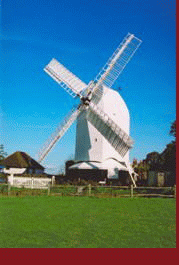




  |
 |
   |
 | ||
      |
  |
| www.oldlandwindmill.co.uk |
| Diary Volume 2 September 2005 to December 2006 |
| Oldland Windmill is an 18th century post-mill situated in the village of Keymer in the County of West Sussex. She is currently being restored to full working order by a dedicated team of local volunteers. |
|
 |
Spring Sweeps We are entering uncharted waters here . . . . . Spring loaded sweeps were used in Sussex and Kent from circa 1770. As far as we know there is only one other mill left that uses this system. That mill is not working and the layout is different from Oldland. We have only one of the old sweeps left and that is not complete. We have at least one of each of the metal fittings that we have copied. We have some old photos which give use a reasonable guide as to where everything goes. It will be interesting putting it all together and seeing how it works. |
The idea is that the spring holds the shutters closed and, should the wind increase, then the shutters will partly open against the spring tension and prevent the speed increasing. The tension in the spring is set by putting the spring control rod hook into different holes in the bracket. The Miller's experience will guide him as to what spring tension to set in the prevailing wind conditions. The setting of the shutters is done when the tip of each sweep can be reached from the ground and each one has to be done in turn. Once the sweeps are turning they cannot be further adjusted. This means that the brake will be hard used, as it will have to bring the sweeps to rest with full power on. | |
 |
|
One can well understand why the later system, of a single control rod running through the centre of the windshaft to operate all four sets of shutters, caused spring sweeps to be abandoned. | |
 | ||
| NOTES ON SKETCH Pulling on hook (A) and fitting the hook into a hole in bracket (B) applies tension from the spring to the chain passing over pulley (E).
Any increase in wind strength will open the shutters against the spring tension and is designed to maintain a constant speed. Transferring hook (A) to bracket (C) will double the tension from the spring for use in stronger winds. This is a diagrammatic sketch and is not to scale. | ||
Diary Update June to November 2006 |
|
Much has been happening since the last update in May of this year. We were saddened to hear that our millwright Chris Wallis had died in April. We knew that he was ill but had not realised how serious his condition was. What a loss to us and all the other mills. His colleague, David Emperingham was left with more work on his books than he could reasonably cope with. DEFRA, having seen the good quality work that we have put into the sweeps, was happy for us to make the brakewheel under Danny Jarmann's supervision. On 9th August David Emperingham returned to us the felloes (O.D. segments of the rim of a wheel supported by spokes) that they had cut from our old elm tree salvaged from the hurricane of '87. These had been planed and shaped a little oversize. We also received sufficient elm to make a new brake and oak for the clasp arms (the spokes that support the rim of the wheel) |
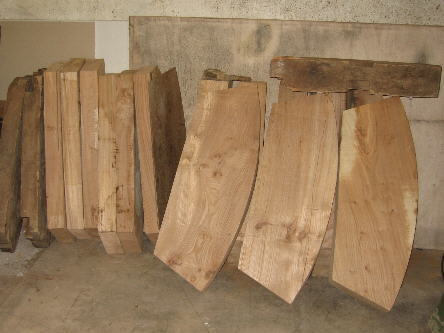 Elm blanks for brakewheel supplied by David Emperingham |
I think that making a brakewheel from new is such a significant project that, rather than mixing up its progress with the rest of the restoration, that this will be shown on a separate page. |
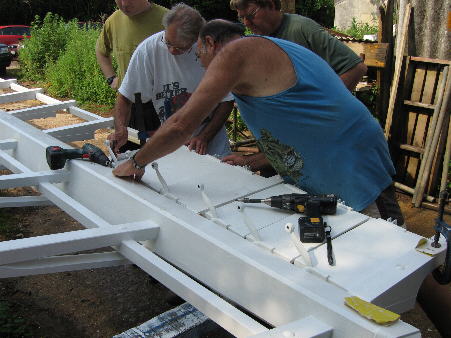 Trial set of leading edge shutters |
We had a few castings for the shutter pivots that Willesborough Windmill gave us and these were made from the same set of patterns as the new castings that we are still waiting for. This enabled us to fit a few of the leading edge shutters. |
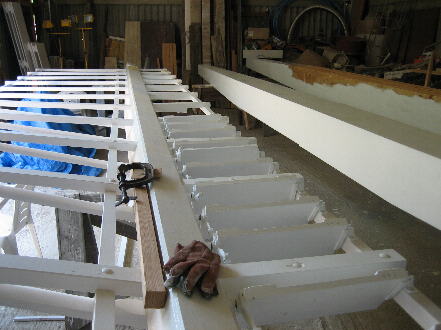 Trial set of leading edge shutters - Photo : Gordon King |
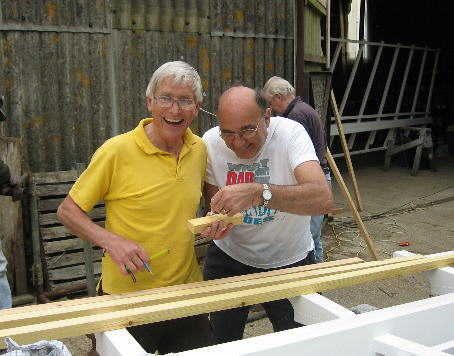 You gotta have a laugh- Photo : Gordon King |
|
Also during June we finished painting all the shutters and screwed on the few levers and pivots that we had from Willesborough Mill, We are still waiting for our new castings from Allen's Foundry at Ashford. The stocks were planed to size, preservative applied and then under and top coated. |
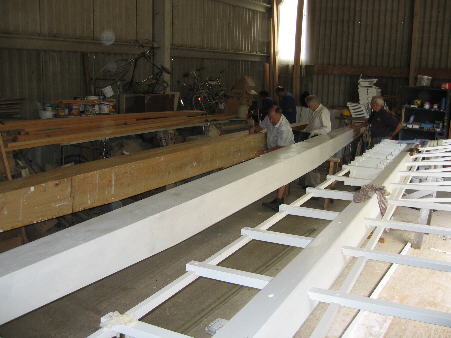 One stock painted and the other being planed |
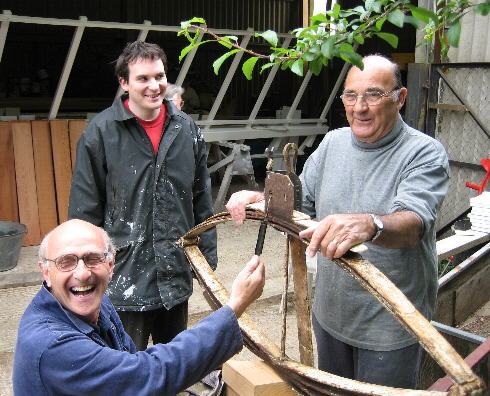 Successful old spring test - Photo : Gordon King |
The angle of the shutters is set with a chain running to the outer end of each sweep and are set from the ground one sweep at a time. This chain is linked to a double elliptical spring. The angle of the shutters are set according to the wind strength and if the wind increases then the pressure on the shutters works against the spring and allows the shutters to open and bring the speed back down to the original setting, and the opposite if the wind decreases. We had some of the original springs but not a complete set so it was decided to have four new sets made to as near the same strength as we could determine. |
At the beginning of July we had a very welcome visit by a workforce of a dozen or so from the Burgess Hill offices of American Express. A cheerful and hardworking crowd of youngsters ( well, compared to most of us). They gave us a good spring clean before the next Open Day. |
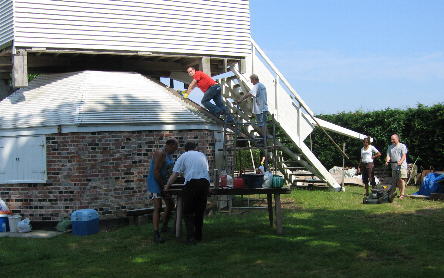 The American Express helpers |
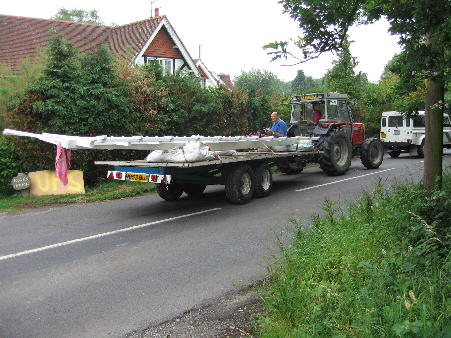 Two sweeps leaving the Barn |
The 6th of July was a big day. Plumpton College came with a tractor and trailer and took the first two sweeps from the Barn up to the Mill. |
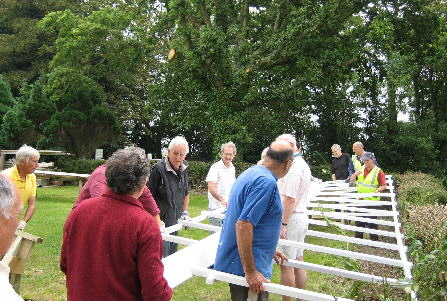 Carrying a sweep in from the trailer - Photo : Gordon King |
 The first two sweeps at Oldland Windmill |
|
9th July was our second Open Day of the year. The minibus was kept busy taking visitors to and from the car-park that the Thatched Inn very kindly let us use. Lots of visitors, some new exhibits, shutters being sold, very welcome donations to The Mill, thank you all. |
 July Open Day - Photo : Gordon King |
 Photo : Gordon King |
Historic road racing series Vincent, 1300cc, Still a winner on most British circuits. Built and ridden by John Renwick. Where do you think you are off to ? |
|
Most of July was spent marking time. We were waiting for the brakewheel parts to be delivered and also for the castings for the shutter pivots. The time was well spent as we cleared years of accumulation of rubbish and even got paid for a lot of old iron. In August it all went mad, the parts for the brakewheel were delivered and also the metal castings. Jill Windmill lent us a substantial workbench Roy and David raided their workshops and we soon had three drills and a bench grinder fitted up. All hands to works, grind off the rough edges of the iron castings, make templates to mark where to drill, pilot holes, drill to size, countersink, wire brush, galvaroid under coat plus a white undercoat. Lots of dirty work. |
 Metal working section - Photo : Gordon King |
 Hard at it - Photo : Gordon King |
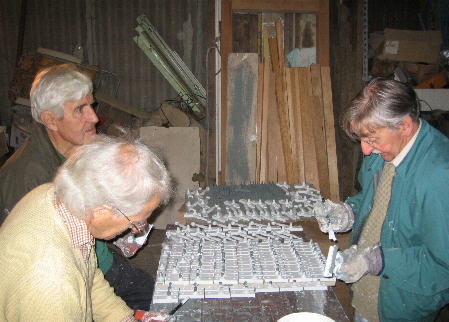 Simon, Peter and Don, yet more painting - Photo : Gordon King |
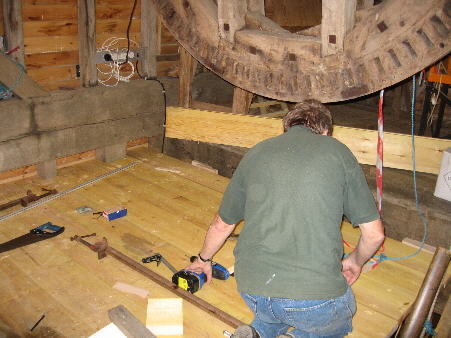 Keith laying floor-boards to Stone Floor |
Diverting here from the general theme. We have acquired a grinder, and we are appealing for help in deciding what the piece of machinery is. We believe it is a hand flour mill. I finished restoring it and it was on display at Jill Windmill on the Alternative Power Event 6th August. We tried to grind wheat and got about 20% flour and 80% bran so either it is not a flour mill or I have not got it set up correctly. Despite all the knowledgeable exhibitors and visitors we are still no further forward in identifying what it is or who made it. Help please. |
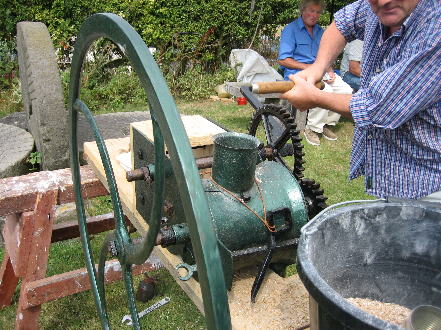 Flour mill ? At Jill Windmill Alternative Power event - Photo : Gordon King |
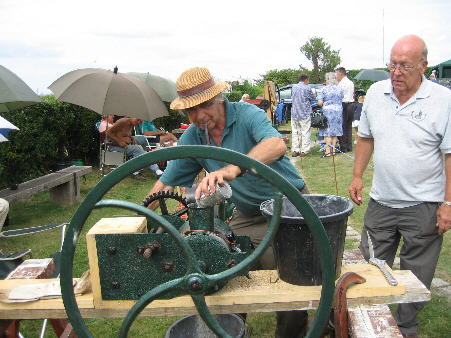 David making a very little flour |
|
The last Open Day of the year was on 24th September. A very GOOD DAY. Over 300 visitors, a record. All the shutters have been sold bar one which was auctioned by sealed bids. Click here for details of the winners of the sealed bid. We had displays of the traditional craft of wood turning using a pole-lathe and a working demonstration of three early petrol ignition engines driving old milling machines. Thanks to Geoff Pink and John Peters respectively. |
|
Don't forget to visit the Village Market in Hassocks on the fourth Sunday in every month. We will be having a stand there in October and November selling some beautiful Christmas cards showing the Mill in winter as well as souvenirs which make ideal Christmas presents. Look forward to seeing you there. |
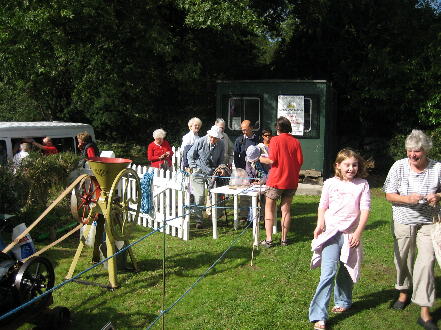 September Open Day - Photo : Gordon King |
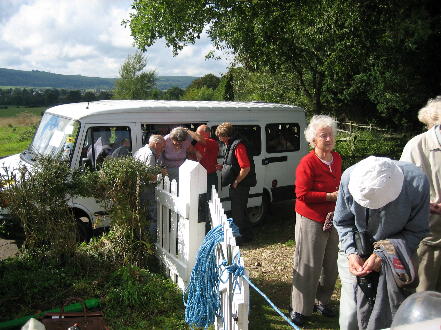 September Open Day - Photo : Gordon King |
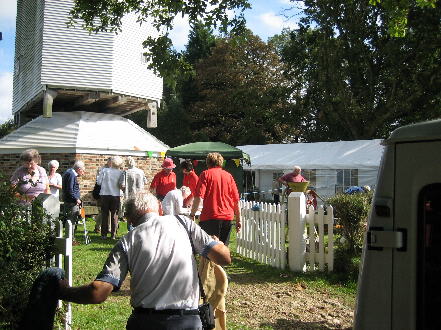 September Open Day - Photo : Gordon King |
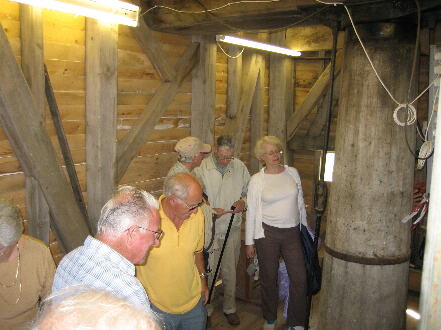 September Open Day - Photo : Gordon King |
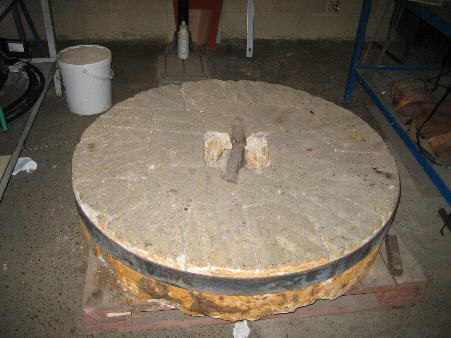 Iron bands for the millstones - Photo : Gordon King |
Whilst all this has been going on, Plumpton College blacksmith workshop has been fitting new iron bands to our old millstones. Gordon King went along to see them at work and took both still photos and video for his film. We are all looking forward to seeing it. When are we going to have a preview Gordon ? |
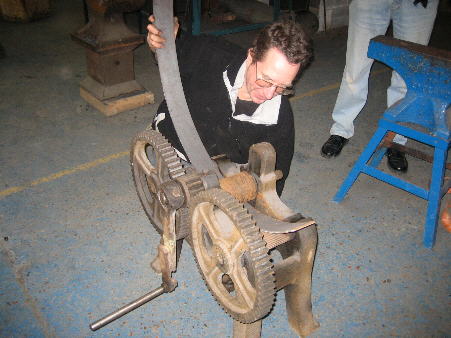 Iron bands for the millstones - Photo : Gordon King |
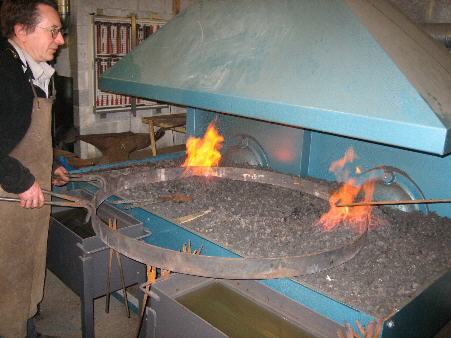 Iron bands for the millstones - Photo : Gordon King |
|
We ran into a problem with some of the metal castings for the shutter pivots. The wooden patterns for the casting have a taper on the pivot to enable the pattern to be removed from the sand box. If we drilled out the closed eyes large enough for what Danny describes as a "rattle fit" then there would not be much metal left . The "rattle fit" is required to stop the shutters binding up when the sweep flexes. We considered turning the pivots down on a lathe but the castings are not accurate enough to be placed in a jig and it would have meant setting each one up separately. Possible, but time consuming. Yet again Colin Moon came to our rescue and made us a hollow end mill to fit in a drill. This works a treat. |
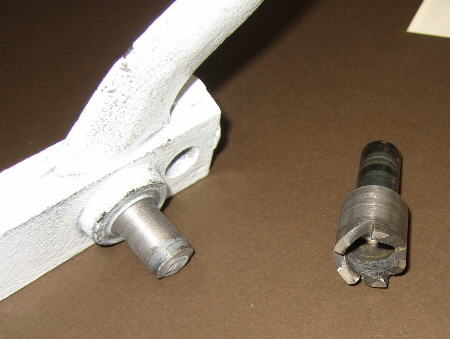 End milling tool made by Colin Moon |
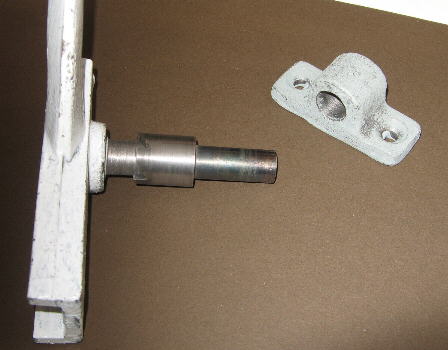 End milling tool made by Colin Moon |
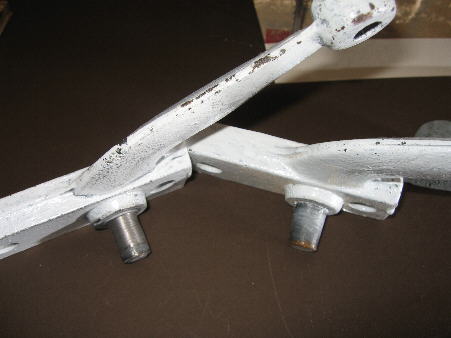 Taper on pivot before milling and after milling |
|
POWER, or the lack of. The Barn that Alan Jenner kindly lets us use does not have a power supply. Alan Fitch lent us a 1.5 Kw generator which was OK for a few lights, sanders and small planes but as more work is taken on so that is not enough. Roy Short added his 2.5Kw generator but now even that is barely enough. It was decided that buying a new 5Kw diesel generator would be a good use of our funds. Many thanks to Alan and Roy for the loan of your generators for the last two years. D.A.F. 12/11/06 |
Diary Update March to May 2006 |
||
Since the last entry in February I am pleased to say that much progress has been made. Now that we have something to get our teeth into, it has stimulated our workforce after a rather slow 2005. We now have around a dozen on Thursdays and a few less on Tuesday mornings. | ||
|
At the beginning of March the first sail-bars, of pitch pine, were fitted. The boards for the shutters were ordered as prepared cedar, but were delivered as rough sawn and wet. We had to spread them out to dry before we could start sanding them. | 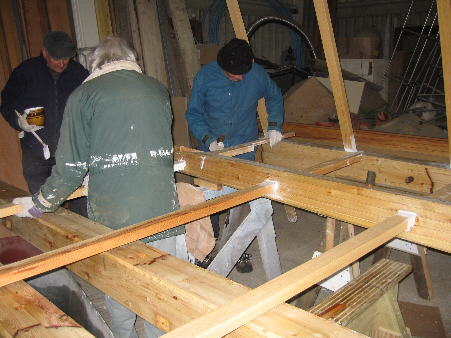 Sail-bars being fitted | |
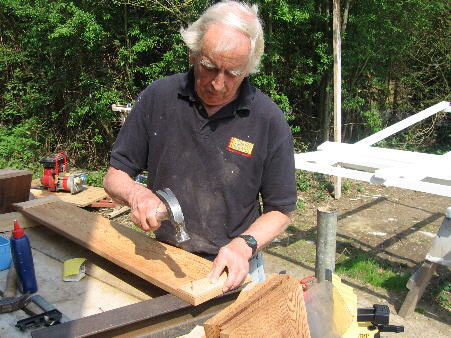 Alan clenching fillets to shutters | We bought a new bandsaw, a fairly sturdy machine which cuts up to 7 inches thick. This has proved to be a great help with all the fillets (much debate about what to call these reinforcements to the end of the shutters, the Diarist was told "fillets" was not correct, but the critics could not come up with anything better, so until someone can give a definitive answer, the Diarist has editorial freedom), 408 of them, which have to be bronze clenched to the ends of the shutters. 204 shutters x 2 fillets x 6 nails per fillet = 2448 bronze nails. |
|
By the end of March the first sweep had all the sail-bars fitted. Each mortise was cut at a different angle so that the sweep is curved like an aircraft propeller. This was done long before ship or aircraft propellers where invented. (someone is going to point out that Leonardo da Vinci or Archimedes had made them). | 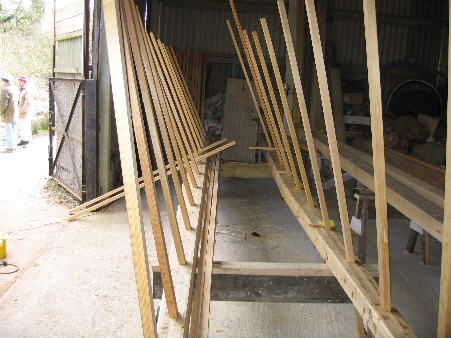 Sail-bars fitted showing curves |
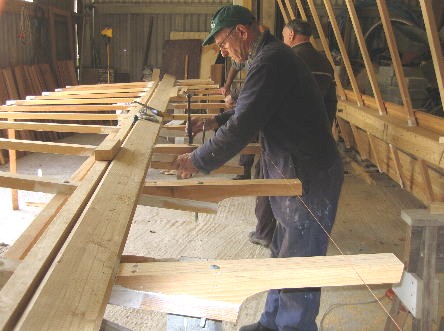 Fred working on sweep 3 |
The three longitudinal frame members, hemlaths and uplongs, were fitted and the whole sweep painted with three undercoats and one topcoat . The other three sweeps were following behind in various stages of assembly. |
|
Danny and I went to Ashford in Kent, firstly to Willesborough Windmill where they kindly lent us wooden patterns to have the shutter levers, pivots and open and closed eyes, cast in iron. We then went on to Allenís Foundry to get a quote. These are now on order and we are quoted mid June for delivery. Willesborough also let us have some shutter fittings that they did not need. Sufficient to fit leading edge shutters to two sweeps. Many thanks. |
|
Sunday 14th May was an Open Day. Dull with a cool breeze but it stayed dry. We were introduced to our latest volunteer, Mary Hayler, who is our P.R. lady (I think that maybe the title now-days is Media Relations). This is work that she does for East Sussex County Council as her day job and she got off to a splendid start by greeting all our many visitors with a smile. |
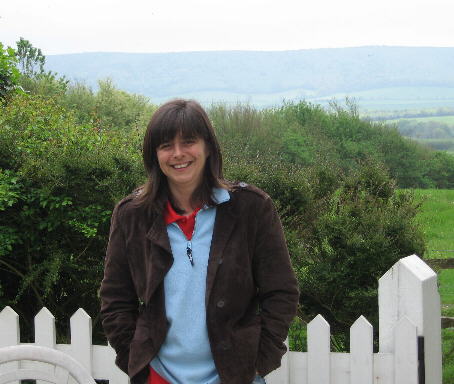 Mary Hayler our Media Officer |
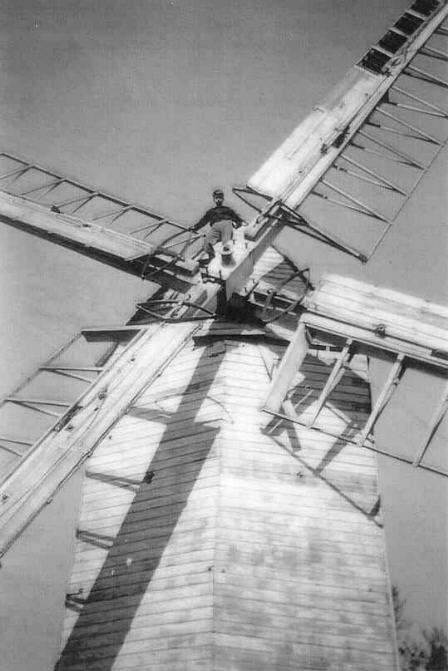 1949 - John West perched on the canister |
There were lots of memories of the old days.
One gentleman recalled finding some tins of black market food hidden in the derelict mill during the war. He took some home and as he put a £5 in our box he said that at last his conscience was clear after all these years.
Another gentleman [John West] produced a fine photo of himself perched on the canister in the centre of the sweeps. It was taken when he was a lad in 1949. He hopes to repeat the photo when we get the new sweeps back on.
Two brothers recalled the time when they both worked for the neighbouring farmer, Thurston Matthews, during the war. His nephew, Edgar Matthews, is the current farmer. |
|
We started selling shutters at £10 for the trailing edge ones and £5 for the leading edge. Each shutter will be numbered and there will be a plan of the sweeps in the mill showing each purchaserís name and where their shutter is. We were pleased to see Reg Adsett, one of our earliest fund raisers, who bought a shutter. We raised over £500 for shutters on the day, but there are plenty left to sell. YOUR CHEQUE WILL BE WELCOME. |
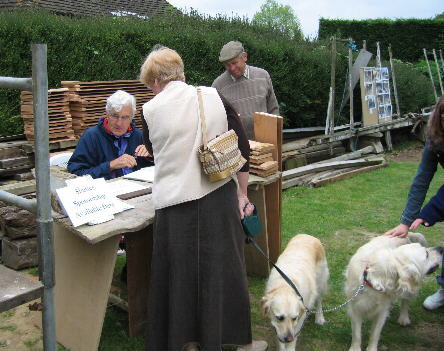 Simon signing up shutter buyers on Open Day 14th May 2006 |
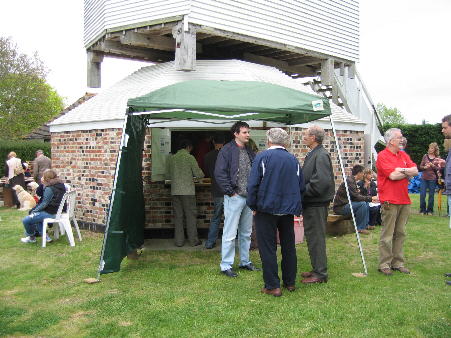 Open Day 14th May 2006 |
Teas and cakes were sold out and altogether we raised a little over £1100. Many thanks to you all. |
|
By the end of May all the sweeps are painted and the back braces are being fitted. There is a production line, of a sort, for the shutters, cut to size, sand down, clench on end fillets, machine down ends to take levers and pivots, treat with preservative and paint. The first few are coming off the line with a single undercoat. |
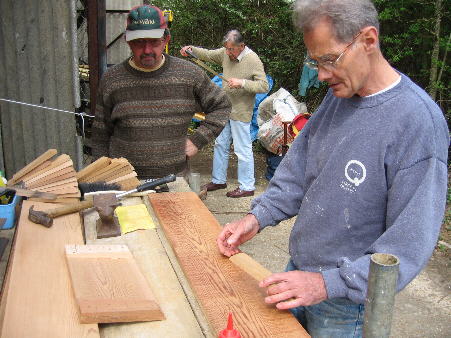
| Mick gluing fillets to shutters |
| Roy machining end of a shutter |
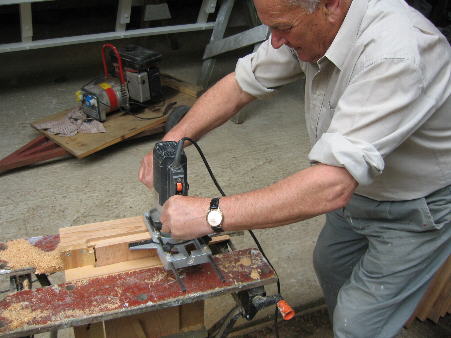
|
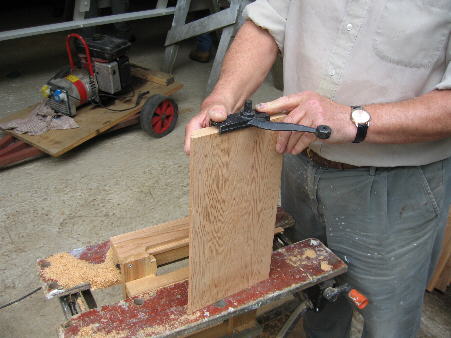
| Roy checking fit of lever after machining |
| Trial fit of first leading edge shutter |
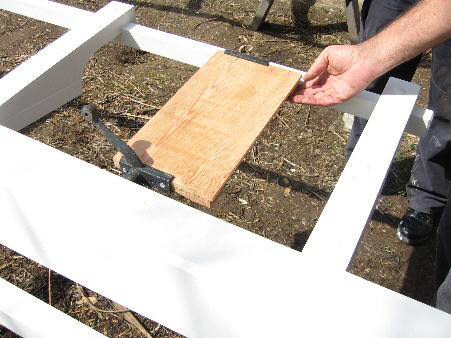
|
|
Stop the presses. Latest at 25th May:
|
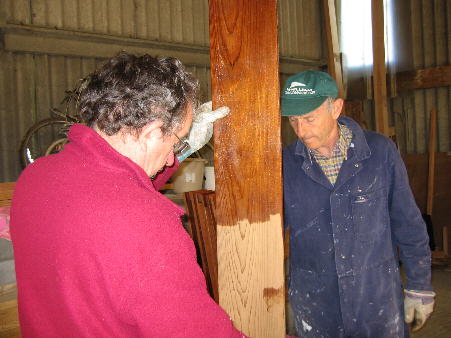 Fred and Colin painting preservative onto the shutters | 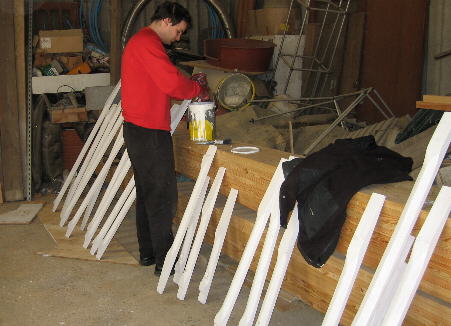 Philip painting back braces |
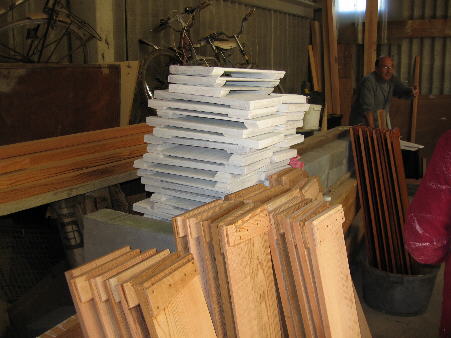 Shutters in progress | 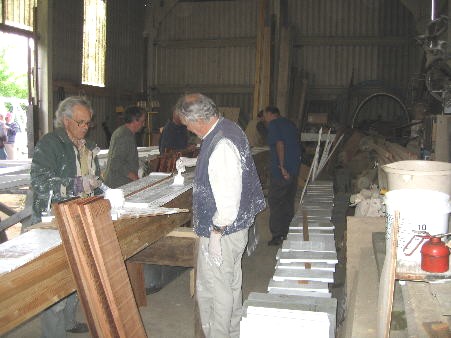 Production line painting shutters |
Diary Update August 2005 to February 2006 |
| We are all sorry to hear that Geoffrey Hawkings-Byass has died .
He has been our neighbour in The Millhouse since before the restoration project was started
in 1976. Over these many years he has been a benefactor and source of encouragement to
Oldland Mill and her workers.
AUGUST 2005.
|
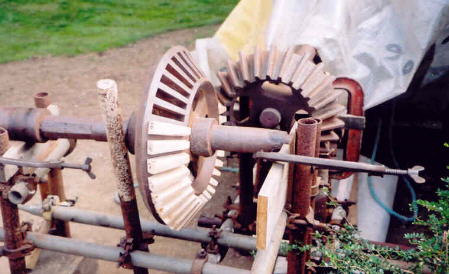 |
Auxiliary drive to stone shaft spindle set up square in a jig to fit new hornbeam teeth | |
| Made new holly bearings for the stone shaft spindle from timber saved by Chris Taylor after the hurricane of 1987. |  Holly grease-stick as part of the holly bearings to the stone shaft spindle |
|
Gerry has spent much of the month fitting wood inserts to reinforce one of the original
beams that supports the rear pair of stones.
The site has been largely cleared of old timber and rubbish that has accumulated over many years and sown with grass seed. The old iron machinery is being taken out of store and de-rusted. SEPTEMBER 2005.
|
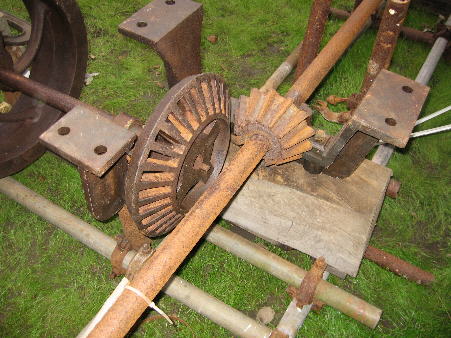 |
Part of sackhoist drive showing the iron frame which needs to be fitted with wooden teeth |
|
We had a very good Open Day on 25th September. Many visitors,
meeting old friends and making new ones . Over the year we raised about
2000 much needed pounds with various events.
OCTOBER 2005.
|
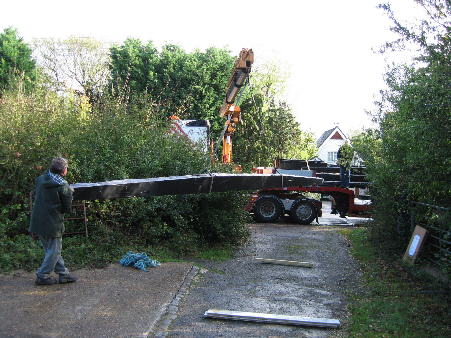 |
The stocks and whips being craned onto the Barn site |
|
NOVEMBER 2005.
The Gale. The wind was so strong that it turned the mill, dragging the steps sideways about six feet. Just as well that we had fitted straps to hold the trestle to the brick piers earlier in the year. We cleared the Barn so that we have room to make the sweeps and made trestles to support the whips and stocks. We have no mains electricity but have a couple of generators for which we have made a shed outside the barn. |
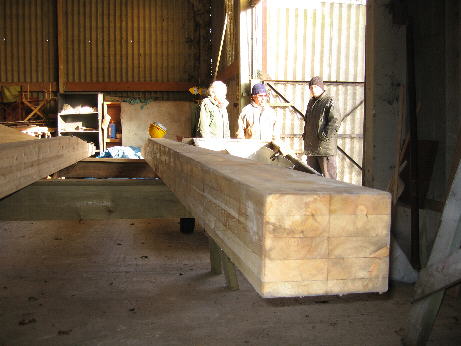 |
End view of one of the whips, 29 feet long, showing the laminations |
| One of the few original timbers that we have used in the new frame is the beam that supports the thrust bearing at the rear of the wind-shaft. A recent survey has shown that its strength is marginal and we have installed a steel girder to reinforce it. |
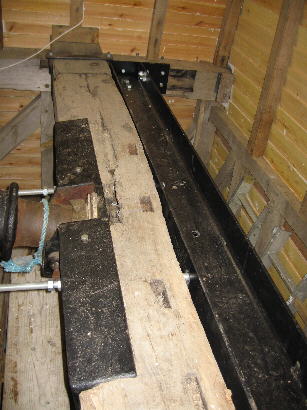 |
Steel girder supporting the windshaft tail beam |
|
JANUARY 2006. We are working on the series of levers that raise and lower the runner stone on the front pair of millstones. This is using some of the original timbers and some new ones. |
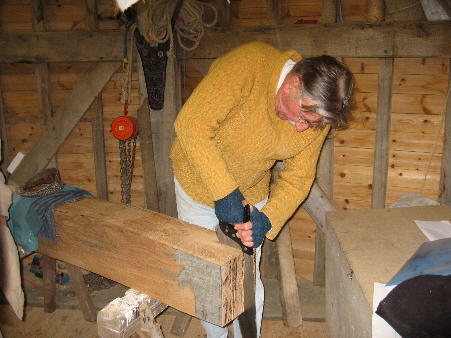 |
Don cutting a tenon on a new runner stone lever |
| Millwright Danny Jarmann (on the right) marking out a whip |
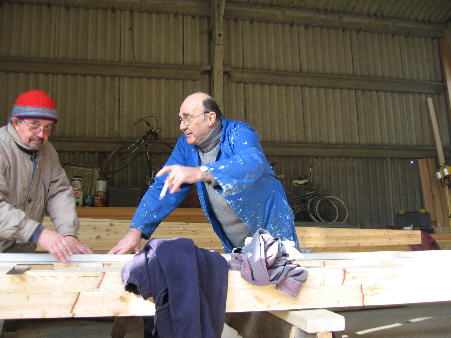 |
|
The rest of the small timbers for the sweeps have been delivered.
FEBRUARY 2006.
|
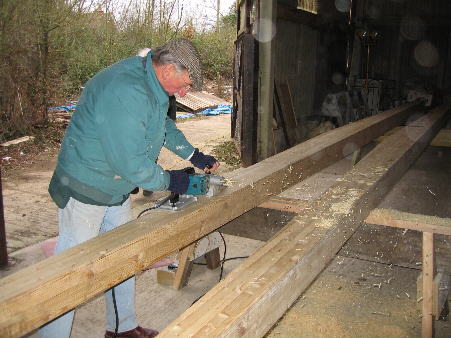 |
Don taking the first cut with a plane on the first whip.
We have made a start ! ! |
| On 9th February the mortises for the sailbars were rough cut in the first whip and now have to be fine finished to fit, each one at a different angle. |
| Roy cutting a mortise in the first whip |
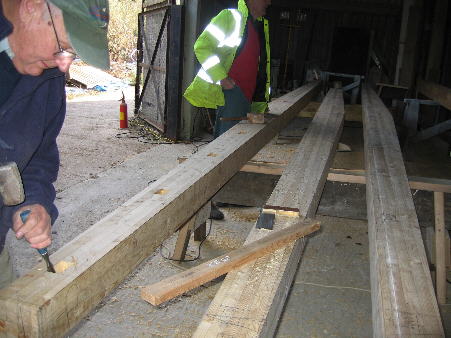 |
|
By February 23rd, 12 mortises in each whip have been cut for the sail bars.
The first whip has been profiled, chamfered and treated with preservative.
D.A.F. 27/2/2006. |
 |
 |
   Click here to visit Techpoint website |